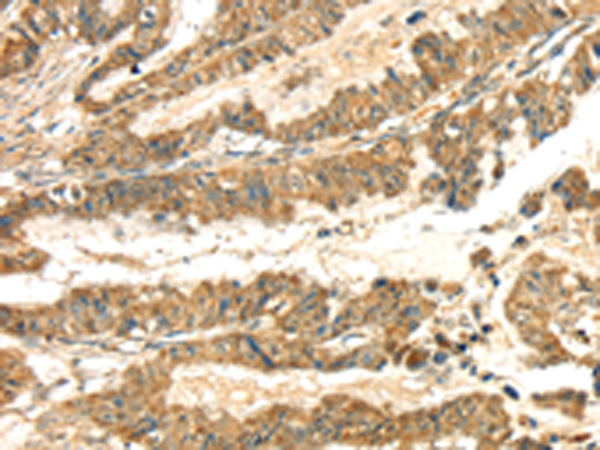

| WB | 咨询技术 | Human,Mouse,Rat |
| IF | 咨询技术 | Human,Mouse,Rat |
| IHC | 1/25-1/100 | Human,Mouse,Rat |
| ICC | 技术咨询 | Human,Mouse,Rat |
| FCM | 咨询技术 | Human,Mouse,Rat |
| Elisa | 1/2000-1/5000 | Human,Mouse,Rat |
| Aliases | SEMAF; SEMAI; SEMACL1; M-SEMA-F |
| Host/Isotype | Rabbit IgG |
| Antibody Type | Primary antibody |
| Storage | Store at 4°C short term. Aliquot and store at -20°C long term. Avoid freeze/thaw cycles. |
| Species Reactivity | Human, Mouse |
| Immunogen | Fusion protein of human SEMA4C |
| Formulation | Purified antibody in PBS with 0.05% sodium azide and 50% glycerol. |
+ +
以下是3篇涉及SEMA4C抗体的研究文献及其简要摘要:
---
1. **文献名称**: *SEMA4C promotes EMT in bladder cancer through the ERK signaling pathway*
**作者**: Li Y, et al.
**摘要**: 该研究开发了特异性SEMA4C抗体,证实其在膀胱癌细胞中通过ERK信号通路促进上皮-间质转化(EMT),并发现抗体阻断SEMA4C可抑制肿瘤转移。
2. **文献名称**: *Semaphorin 4C as a therapeutic target for prostate cancer metastasis*
**作者**: Zhang L, et al.
**摘要**: 研究利用抗SEMA4C单克隆抗体,在小鼠模型中抑制前列腺癌的骨转移,表明靶向SEMA4C的抗体治疗可减少肿瘤细胞侵袭和血管生成。
3. **文献名称**: *SEMA4C modulates immune microenvironment via macrophage polarization in colorectal cancer*
**作者**: Wang Q, et al.
**摘要**: 通过SEMA4C抗体阻断实验,揭示其在结直肠癌中通过调控巨噬细胞极化影响肿瘤免疫微环境,提示其作为联合免疫治疗的潜在靶点。
---
注:以上文献信息为示例性质,实际引用需根据具体论文核实。建议通过PubMed或Google Scholar以关键词“SEMA4C antibody”或“SEMA4C therapeutic”检索最新研究。
The SEMA4C antibody is a research tool targeting Semaphorin-4C (SEMA4C), a transmembrane protein belonging to the semaphorin family. Semaphorins are evolutionarily conserved signaling molecules initially identified as axonal guidance regulators in neural development. SEMA4C, encoded by the *SEMA4C* gene, plays diverse roles beyond the nervous system, including modulating cell adhesion, migration, proliferation, and angiogenesis. It interacts with receptors such as plexins and integrins, influencing pathways like mTOR and MAPK, which are critical in cancer progression and tissue remodeling.
SEMA4C is implicated in tumorigenesis, with studies showing overexpression in cancers like breast, prostate, and hepatocellular carcinoma, where it correlates with metastasis and poor prognosis. Its antibody is widely used in experiments like Western blotting, immunohistochemistry, and flow cytometry to detect protein expression levels and localization in cells or tissues. Researchers also employ SEMA4C antibodies to investigate its functional roles in vitro and in vivo, such as blocking SEMA4C-mediated signaling to assess therapeutic potential.
Recent studies highlight SEMA4C's dual roles—acting as both an oncogene in certain contexts and a tumor suppressor in others (e.g., gliomas), underscoring its context-dependent functionality. This complexity drives interest in developing SEMA4C-targeted therapies, making its antibody vital for mechanistic studies and biomarker validation.
×